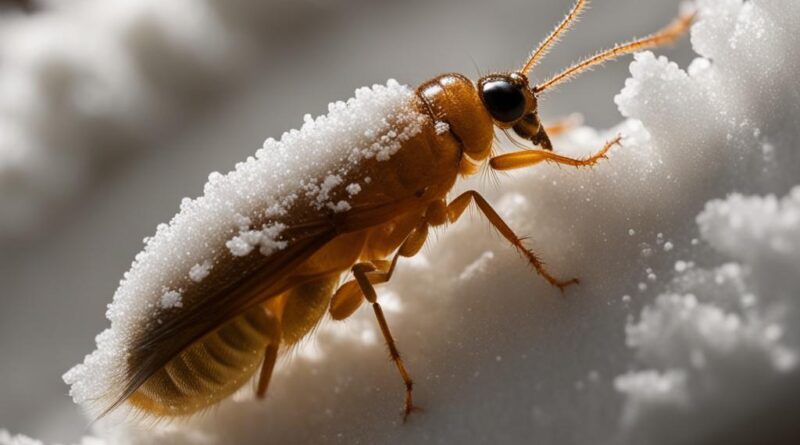Snow Fleas in House – Prevention & Removal Tips
If you’ve noticed small jumping specks in your house, you may be dealing with snow fleas, also known as springtails. These tiny arthropods can become a nuisance if they find their way indoors. While snow fleas don’t pose any harm to humans or pets, it’s essential to prevent and remove them to maintain a pest-free home environment.
Key Takeaways:
- Snow fleas, or springtails, are small arthropods that can be mistaken for fleas.
- They are not harmful but can become a nuisance if they enter your home.
- Prevent snow fleas by addressing moisture issues and removing decaying matter.
- Control snow fleas using natural remedies or insecticides.
- Regular cleaning and maintenance can help prevent snow flea infestations.
What are Snow Fleas?
Snow fleas, scientifically known as springtails or Hypogastrura nivicola, are tiny insects that are highly active during the winter months. They are not actually fleas but are called so because of their ability to jump.
Snow fleas have an elongated oval shape, measure about 1/16 of an inch or 1.5 millimeters long, and come in black or dark blue color. They have six legs, a stiff tail-like appendage called a furcula used for jumping, and two clusters of compound eyes.
Proper identification of snow fleas is essential to avoid using ineffective insecticides. Although they may be mistaken for fleas due to their jumping ability, snow fleas are distinct creatures with their own characteristics.
| Traits of Snow Fleas | |
|---|---|
| Shape | Elongated oval |
| Size | Approximately 1/16 of an inch or 1.5 millimeters long |
| Color | Black or dark blue |
| Legs | Six |
| Jumping Mechanism | Stiff tail-like appendage called a furcula |
| Eyes | Two clusters of compound eyes |
Knowing these characteristics can help you accurately identify snow fleas and distinguish them from other insects or pests.
Quote:
“Snow fleas are not actually fleas but are called so because of their ability to jump.”
Signs of Snow Fleas in the Home
Snow fleas are primarily found in outdoor environments where they feed on decaying organic matter. However, under certain conditions, they can make their way into homes. This can happen when there is a lack of moisture or decaying matter in their outdoor environment or when there is excessive moisture indoors. While snow fleas are harmless to humans and pets, their presence can be a nuisance and may cause damage to paper or fabric products due to their waste.
If you suspect a snow flea infestation in your home, there are several signs to look out for. These signs can help you determine if you have a snow flea indoor infestation:
- Presence of small black specks or jumping flecks on surfaces
- Particularly noticeable on melting snow or areas with moisture
These signs indicate the presence of snow fleas in your home. While they do not pose any direct harm, their presence can be inconvenient and may indicate underlying moisture or cleanliness issues. If you notice these signs, it’s important to take appropriate measures to address the infestation and prevent further indoor infestations.
Preventing Snow Fleas Indoors
To prevent snow fleas from entering your home, it’s important to take proactive measures that create an unfavorable environment for these tiny arthropods. By addressing moisture problems, removing organic matter, and maintaining cleanliness, you can significantly reduce the risk of snow flea infestations in your house.
Address Moisture Issues
- Fix any leaks or moisture problems in your home promptly. This includes repairing leaking pipes, faucets, and faulty air conditioning units.
- Ensure proper ventilation in your home by opening windows, using exhaust fans, or installing ventilation systems.
- Consider using dehumidifiers in areas prone to excess moisture, such as basements or bathrooms, to reduce humidity levels.
Remove Decaying Organic Matter
Snow fleas are attracted to decaying organic matter, so it’s essential to eliminate potential food sources near your home’s exterior. Take the following steps:
- Rake and dispose of fallen leaves regularly.
- Clear away plant debris and trim vegetation near your home.
- Keep woodpiles and compost piles away from the house.
Note: Regular cleaning and vacuuming of your indoor spaces can also help eliminate potential hiding spots and food sources for snow fleas.
Stay Vigilant
While following the preventive measures mentioned above significantly reduces the risk of snow fleas infesting your home, remain vigilant and monitor your surroundings. If you notice any signs of snow fleas or believe you have an infestation, take prompt action to prevent the problem from worsening.
Professional Pest Control
If you are unable to control a severe snow flea infestation or prefer professional assistance, consider contacting a pest control expert specializing in snow flea extermination. They have the knowledge, experience, and tools to effectively eliminate snow fleas and provide long-term pest control solutions.
Remember, prevention is key when it comes to snow fleas. By addressing moisture issues, removing organic matter, and maintaining cleanliness, you can significantly reduce the risk of snow flea infestations and enjoy a pest-free home.
| Preventive Measures | Effectiveness |
|---|---|
| Addressing moisture issues | Highly effective (prevents snow fleas from thriving in a moist environment) |
| Removing decaying organic matter | Highly effective (eliminates potential food sources for snow fleas) |
| Regular cleaning and vacuuming | Effective (reduces snow flea hiding spots and food sources) |
| Professional pest control | Highly effective (ideal for severe infestations or if unable to control the problem independently) |
Snow Fleas Control Methods
When dealing with a snow flea infestation in your home, there are several control methods you can employ. One effective approach is to use residual insecticides both indoors and outdoors. Doxem NXT is a recommended insecticide for indoor crack and crevice treatments, while Supreme IT is a powerful bifenthrin concentrate for perimeter application around the exterior of your home. These insecticides should be applied according to label instructions and precautions should be taken to avoid contact with treated areas until they are dry.
It’s important to consider natural remedies as an alternative to chemical insecticides. Cedar oil, for example, is known for its insecticidal properties and can help repel and eliminate snow fleas. Other natural remedies include essential oils like tea tree oil or lavender oil, which can be diluted in water to create a homemade solution. Additionally, diatomaceous earth, a natural powder made from fossilized remains of marine phytoplankton, can be sprinkled in areas where snow fleas are present to dehydrate and kill them.
“Using a combination of residual insecticides and natural remedies can provide effective control against snow fleas in your house.”
Comparison of Snow Fleas Control Methods
| Control Method | Advantages | Disadvantages |
|---|---|---|
| Residual Insecticides | – Effective for long-lasting control – Can be applied in targeted areas |
– May contain chemicals – Precautions needed during application |
| Natural Remedies | – Eco-friendly alternative – Safe for children and pets |
– May require repeated applications – Effectiveness may vary |
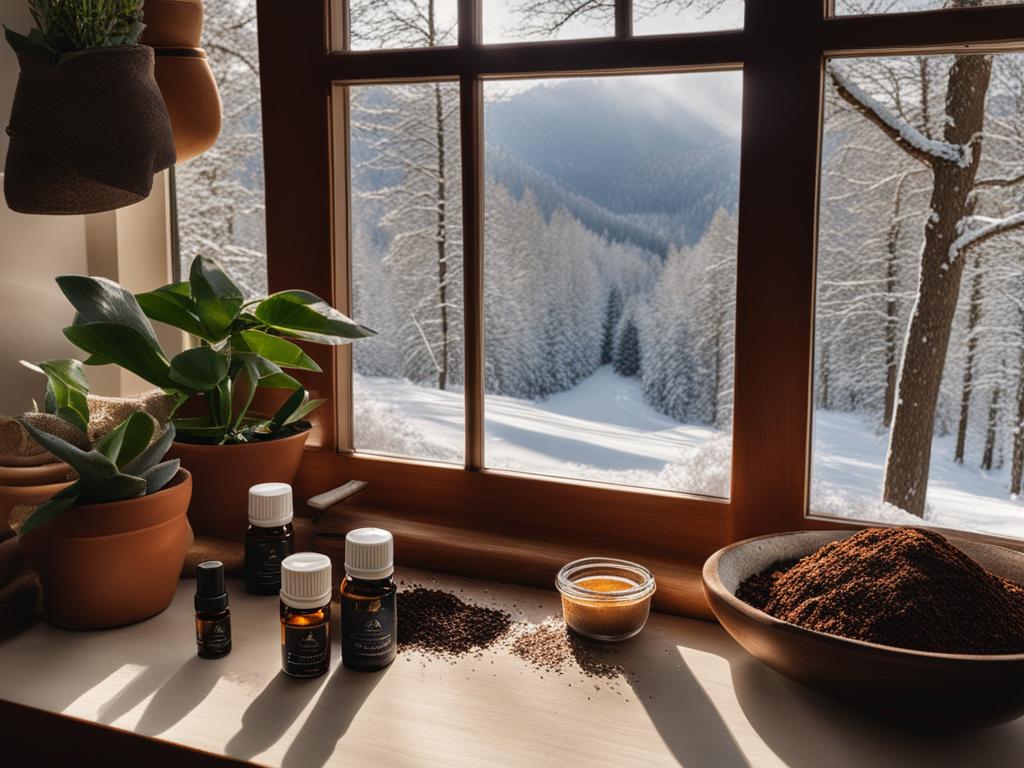
Identification of Snow Fleas
Proper identification is essential when dealing with a snow flea infestation. Snow fleas have distinctive traits that set them apart from other insects.
- Snow fleas have six legs but do not use them for jumping like fleas. Instead, they have a tail-like appendage called a furcula that propels them into the air.
- They are dark blue to black in color, measuring about 1/10 of an inch long.
- Snow fleas have a pair of short 4-segmented antennae.
- These wingless insects have an elongated body and two clusters of compound eyes with ocelli in each eye.
Properly identifying snow fleas will help you distinguish them from other pests, enabling you to implement targeted control measures effectively.
Inspection for Snow Fleas
Conducting a thorough inspection is crucial to determine the extent and locations of snow flea activity. To effectively inspect for snow fleas, it is important to know where they are typically found. Snow fleas are commonly found in moist areas with decaying organic matter, both outdoors and indoors.
Outdoor Inspection
“Snow fleas are typically found in outdoor environments, feeding on decaying organic matter.”
When inspecting outdoor areas, pay close attention to the following locations:
- Leaf litter and forest floors
- Compost piles and wood piles
- Areas with algae and fungi
These areas provide favorable conditions for snow fleas due to the presence of decaying matter and moisture. Look for signs of snow fleas, such as small black specks or jumping flecks on surfaces, particularly in areas where snow is melting or where there is excess moisture.
Indoor Inspection
“Indoors, snow fleas may be found in basements, attics, crawl spaces, and other areas with excess moisture.”
When inspecting indoor areas, focus on spaces with elevated moisture levels. Common areas where snow fleas may be present indoors include:
- Basements
- Attics
- Crawl spaces
These areas tend to have higher humidity or moisture levels, creating an environment suitable for snow fleas. During the inspection, visually look for jumping flecks or black specks on surfaces, and be particularly attentive to areas with moisture or decaying matter.
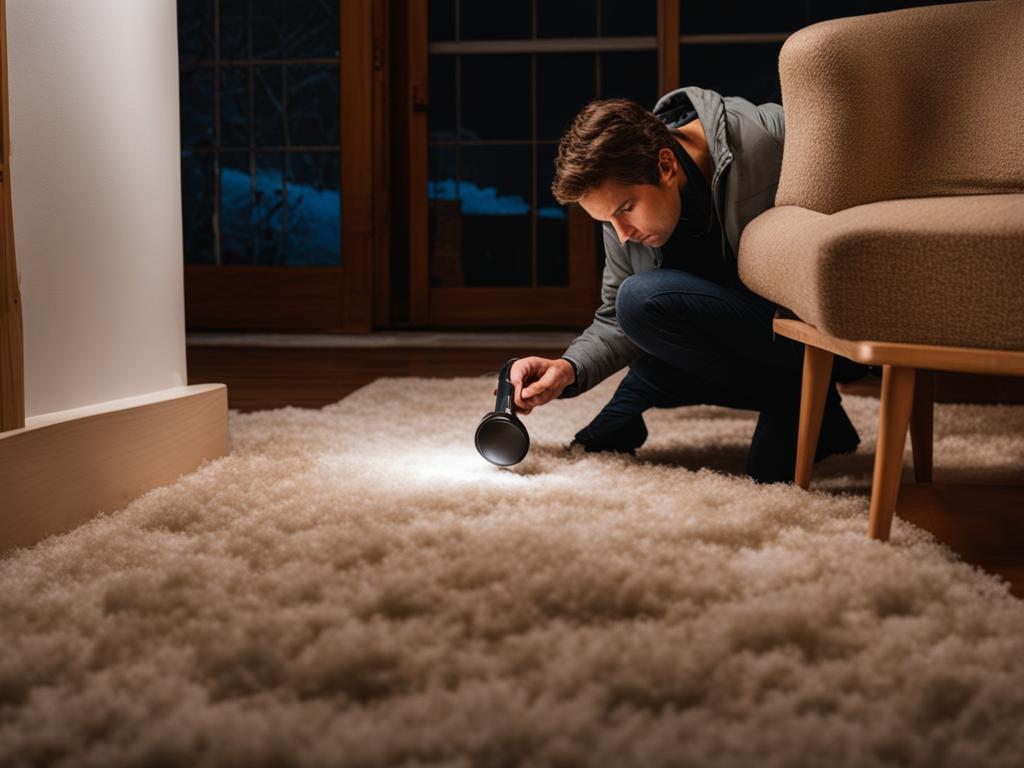
| Outdoor Locations | Indoor Areas |
|---|---|
| Leaf litter and forest floors | Basements |
| Compost piles and wood piles | Attics |
| Areas with algae and fungi | Crawl spaces |
By conducting a comprehensive inspection and targeting areas where snow fleas are likely to be found, you can identify the extent of the infestation and plan an effective treatment strategy. Remember to take necessary precautions during the inspection process to avoid any potential contact with the snow fleas.
Treatment Plan for Snow Fleas
Once snow fleas have been identified and the areas of infestation have been determined through inspection, a treatment plan can be implemented. The first step is to address moisture problems in and around your home to create an unfavorable environment for snow fleas. This includes fixing leaks, improving ventilation, and removing decaying matter.
“To effectively get rid of snow fleas, follow these steps:
- Fix any leaks or moisture issues in your home, such as leaking pipes or faulty air conditioning systems. This will help reduce the favorable conditions for snow fleas to thrive.
- Improve ventilation in areas prone to excess moisture, such as basements, attics, and crawl spaces. This can be done by installing exhaust fans or opening windows to allow for better airflow.
- Remove decaying organic matter from around your home’s exterior, such as fallen leaves and plant debris. This will eliminate potential food sources for snow fleas and discourage their presence.
- Apply residual insecticides to control snow fleas both indoors and outdoors. Doxem NXT is recommended for indoor crack and crevice treatments, while Supreme IT can be used for perimeter application around the exterior of your home. Follow label instructions carefully and take necessary precautions to ensure safe and effective application.
- Implement preventive measures to keep snow fleas from returning. Regular cleaning and vacuuming can help remove any potential food sources and hiding spots. Additionally, consider using natural remedies like cedar oil or essential oils diluted in water to repel snow fleas.
By following this treatment plan, you can effectively get rid of snow fleas and prevent future infestations in your home.
Prevention of Snow Fleas
After successfully eliminating a snow flea infestation, it’s crucial to take preventive measures to keep them from returning. By implementing these preventive strategies, you can ensure a snow flea-free home environment:
- Regular Cleaning and Vacuuming: Thoroughly clean and vacuum your home on a regular basis to remove potential food sources and hiding spots for snow fleas. Pay particular attention to areas where decaying organic matter may accumulate.
- Moisture Control: Fix any leaks or moisture issues in your home, such as plumbing leaks or condensation problems. Consider using dehumidifiers in damp areas to reduce excess moisture, as snow fleas are attracted to moist environments.
- Decaying Matter Removal: Remove decaying organic matter, such as fallen leaves or rotting wood, from your property. Snow fleas thrive on decomposing materials, so keeping your surroundings clean and free from decaying matter can help prevent reinfestation.
- Natural Insecticides: Consider using natural insecticides, like cedar oil, on a quarterly basis to repel snow fleas. Cedar oil is an effective, eco-friendly solution that can help keep these pests at bay.
- Animal Control: Keep animals away from areas where snow fleas are prevalent, as they can carry the pests into your home. Create barriers or use deterrents to prevent animals from accessing snow flea-infested areas.
Taking these preventive measures will greatly reduce the risk of snow flea infestations and help maintain a snow flea-free home environment.
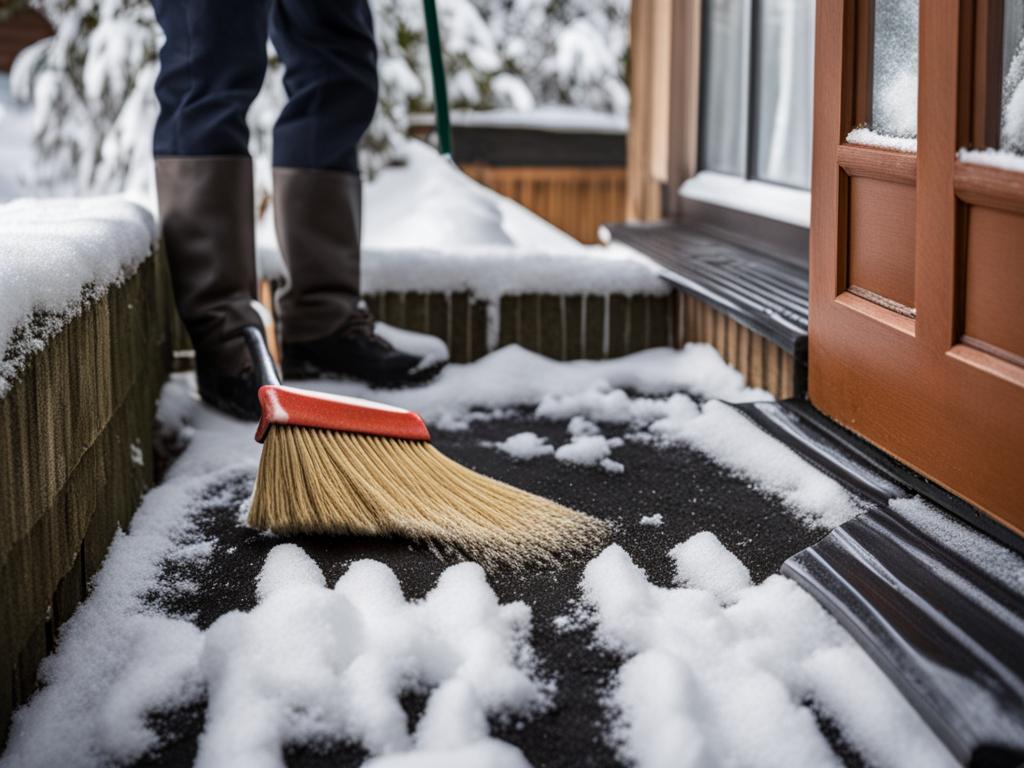
Understanding Snow Fleas and Their Behavior
Snow fleas, also known as springtails, are fascinating creatures that exhibit interesting behavior and habits. They thrive in moist environments and play a crucial role in the ecosystem by feeding on decaying organic matter and contributing to nutrient recycling.
Despite their name, snow fleas do not bite humans or pets. Instead, they use their furcula, a tail-like appendage, to make remarkable jumps and navigate their surroundings. This ability allows them to cover significant distances and avoid potential threats.
While snow fleas are predominantly active during the winter months, specifically on the surface of melting snow, they can be found throughout the year in their natural habitats. Their adaptability and resilience enable them to survive in various conditions, making it important to understand their behavior to effectively prevent and control infestations.
By studying the behavior and habitat preferences of snow fleas, you can implement targeted prevention and control measures. This knowledge can guide you in creating an unfavorable environment for them, reducing their population and minimizing the chances of infestations in and around your home.
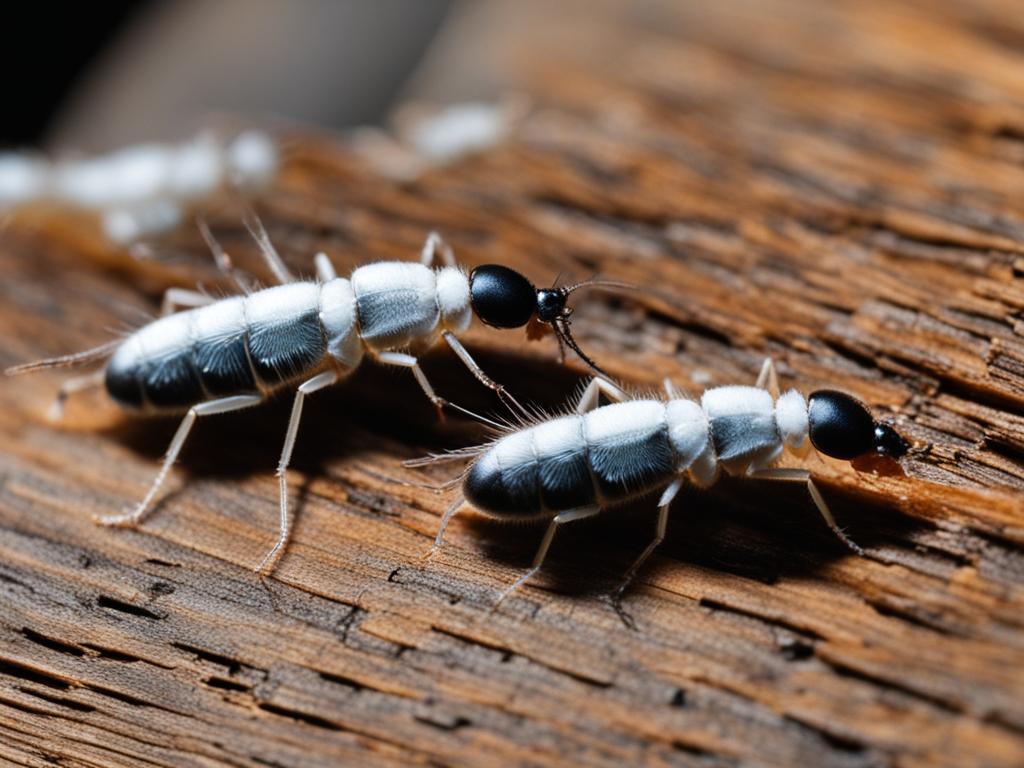
Observing the behavior of snow fleas can also provide valuable insights into their movement patterns and activity levels. This information can help you identify areas of high snow flea concentration and focus your efforts on those specific locations.
“Understanding the behavior of snow fleas is crucial for effective prevention and control. By adapting strategies to their habits, you can keep them at bay and maintain a snow flea-free home.”
Natural Remedies for Snow Fleas
If you prefer to use natural remedies to control snow fleas, there are several eco-friendly options available. These natural alternatives can effectively repel and eliminate snow fleas without the use of chemical insecticides.
Cedar Oil
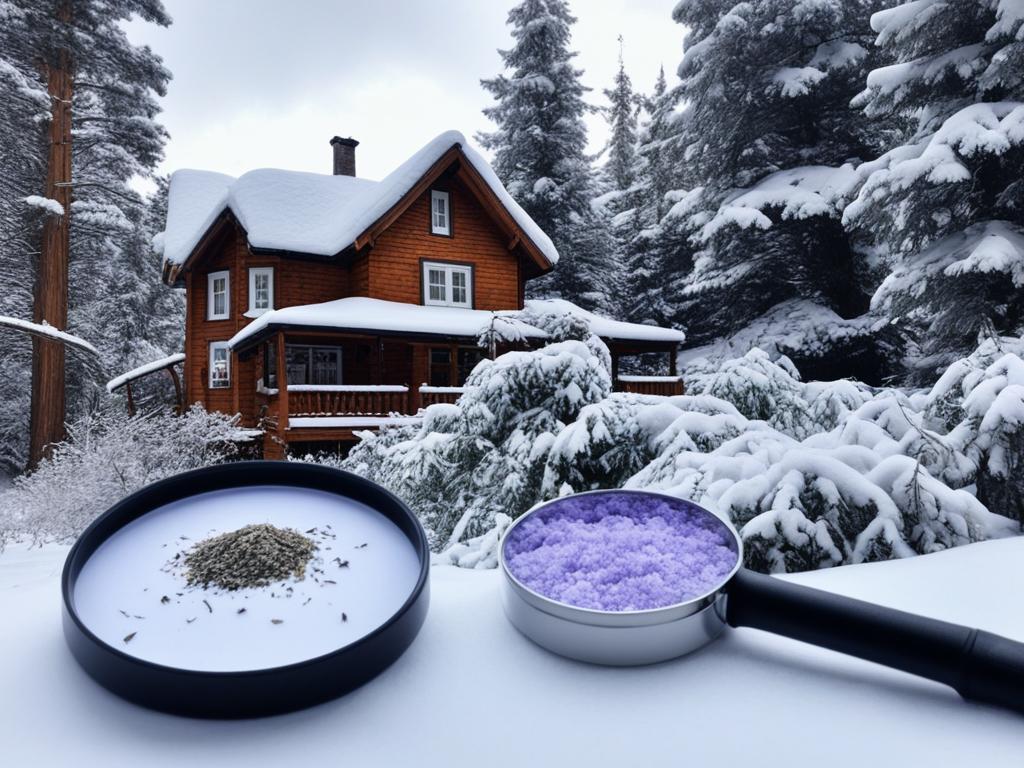
Cedar oil, known for its insecticidal properties, is an effective natural repellent and eliminator of snow fleas. Its strong fragrance acts as a deterrent, preventing snow fleas from entering your home and discouraging their presence. Apply cedar oil around potential entry points, such as doors, windows, and cracks, to create a barrier that snow fleas will avoid.
Essential Oils
Another natural option to control snow fleas is by using essential oils such as tea tree oil or lavender oil. These oils have insect-repellent properties and can be diluted in water to create a homemade solution. Spray the solution in areas where snow fleas are present or likely to be found, such as near entrances or in damp areas.
Diatomaceous Earth
Diatomaceous earth is a natural powder made from fossilized remains of marine phytoplankton. It is safe for humans and pets but lethal to snow fleas. Sprinkle diatomaceous earth in areas where snow fleas are present, such as around the perimeter of your home or in identified infestation sites. This powdery substance dehydrates and kills snow fleas on contact, providing an eco-friendly solution for snow flea control.
By using these natural remedies, you can effectively repel and eliminate snow fleas in an eco-friendly manner. Whether you choose cedar oil, essential oils, or diatomaceous earth, these alternatives provide a safe and sustainable approach to snow flea control.
Addressing Moisture Issues in the Home
Moisture problems in the home create favorable conditions for snow fleas, making it crucial to address and fix any moisture issues to prevent their infestation. By proactively dealing with moisture-related problems, you can create an environment that is less conducive to snow flea survival and reproduction.
Repair Leaks and Improve Ventilation
If you notice any leaks in your home, such as leaking pipes or faulty air conditioning, it’s important to repair them promptly. Leaks not only contribute to excess moisture but also create the perfect conditions for snow fleas to thrive. Additionally, improving ventilation in your home can help prevent moisture buildup, as it allows for better air circulation and the natural evaporation of moisture.
Use Dehumidifiers in Prone Areas
Areas in your home that are prone to excess moisture, such as basements, bathrooms, and crawl spaces, can benefit from the use of dehumidifiers. Dehumidifiers remove excess moisture from the air, reducing the humidity levels that attract and support snow flea infestations. Regularly empty and clean the dehumidifier to ensure its optimal functioning.
Insulate Pipes and Prevent Water Accumulation
Properly insulating pipes can help prevent moisture buildup and condensation, which can attract snow fleas. Insulation minimizes the likelihood of leaks and protects pipes from temperature variations, reducing the risk of excess moisture in your home. Additionally, preventing water accumulation near the foundation of your home, such as ensuring proper drainage and downspout extensions, can further reduce snow flea attraction.
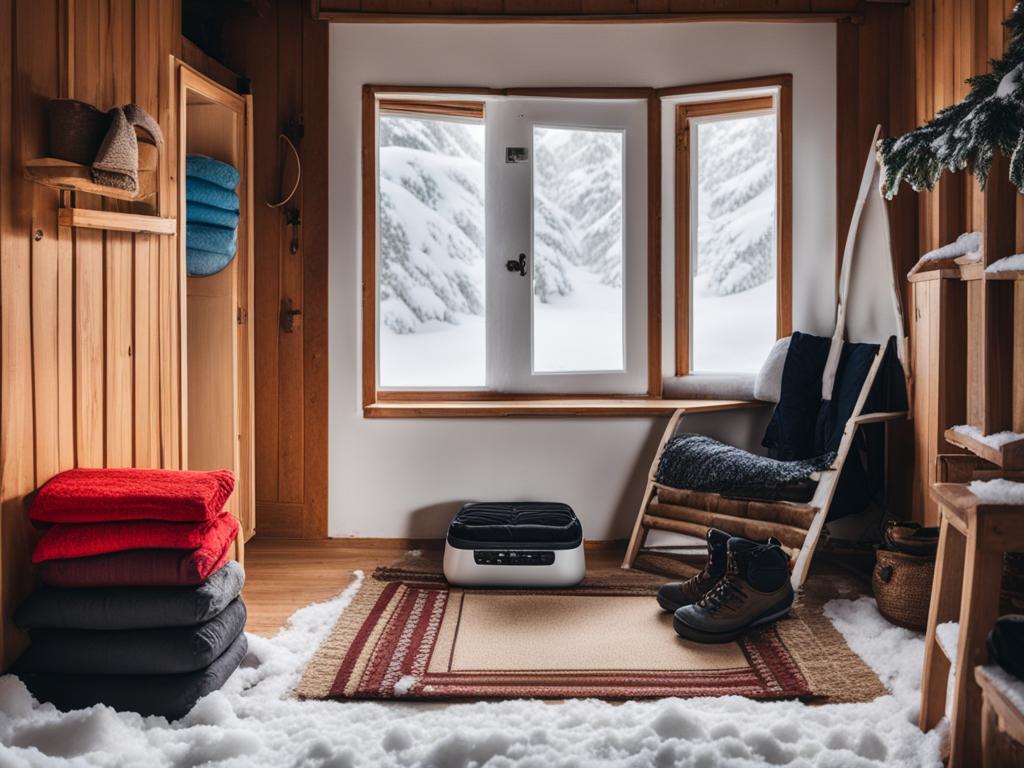
Removing Decaying Matter from the Property
Snow fleas are attracted to decaying organic matter, such as fallen leaves, wood piles, and compost piles. By removing these potential food sources from your property, you can reduce the likelihood of snow flea infestations.
- Rake and dispose of fallen leaves regularly to prevent them from accumulating and providing a breeding ground for snow fleas.
- Properly manage your compost piles by regularly turning them and ensuring they are properly sealed to avoid attracting snow fleas.
- Store firewood away from the house and off the ground, as piles of wood provide an ideal habitat for snow fleas.
Regular maintenance and cleaning of outdoor areas is also essential in preventing the buildup of decaying matter. By keeping your property free from decaying organic materials, you can discourage snow flea activity and reduce the risk of infestation.
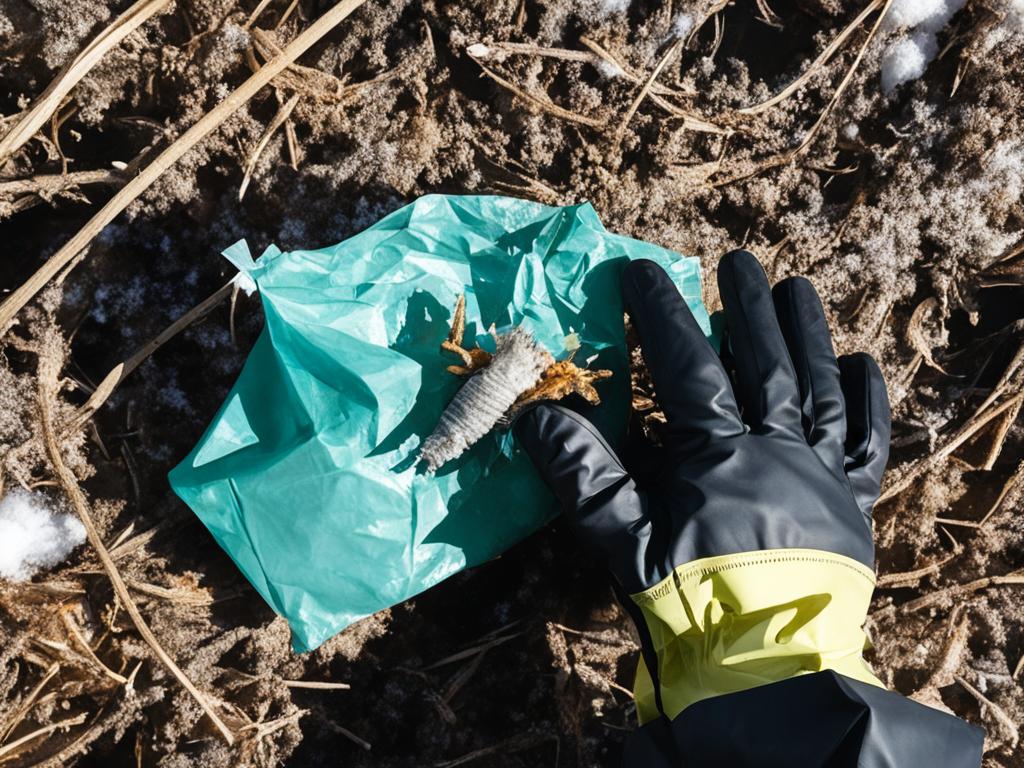
Professional Pest Removal for Severe Infestations
In cases of severe snow flea infestations or if you are unable to effectively control them on your own, it may be necessary to seek professional pest removal services. Pest control experts have the knowledge, experience, and specialized equipment to effectively eliminate snow fleas from your home. They can conduct thorough inspections, implement targeted treatment plans, and provide ongoing monitoring to ensure long-term control. If you are facing a severe infestation or are unable to handle the situation yourself, contacting a professional is recommended.
Conclusion
Preventing and removing snow fleas from your home requires a proactive approach and targeted treatments. By addressing moisture issues, removing decaying matter, using insecticides, and implementing preventive practices, you can effectively combat snow flea infestations. It’s crucial to accurately identify snow fleas and follow the recommended control methods to ensure success.
Begin by fixing any leaks or moisture problems in your home and improving ventilation to create an unfavorable environment for snow fleas. Regular cleaning and vacuuming will help eliminate potential food sources and hiding spots. Remove decaying organic matter from your property, such as fallen leaves and wood piles, as they attract snow fleas. Consider using residual insecticides both indoors and outdoors to effectively control the infestation.
If you prefer natural remedies, options like cedar oil, tea tree oil, and diatomaceous earth can help repel and eliminate snow fleas. However, it’s important to emphasize that natural remedies may be less effective than chemical insecticides. For severe infestations or if you are unable to handle the situation, seeking professional pest removal services is recommended.
Remember, taking swift action is crucial to keeping your home free from snow fleas. By combining preventive measures and targeted treatments, you can successfully prevent and remove snow fleas from your living space.
FAQ
What are snow fleas?
Snow fleas, also known as springtails, are small arthropods that are active year-round. They are not actual fleas but are called so because of their ability to jump. Snow fleas measure about 1/16 of an inch long and come in black or dark blue color.
What are the signs of snow fleas in the home?
Signs of a snow flea infestation in the home include the presence of small black specks or jumping flecks on surfaces, particularly on melting snow or areas with moisture.
How can I prevent snow fleas from entering my home?
To prevent snow fleas from entering your home, address moisture issues by fixing leaks and improving ventilation. Remove decaying organic matter from around your home’s exterior and regularly clean and vacuum to eliminate potential food sources and hiding spots for snow fleas.
What are the control methods for snow fleas?
One effective approach is to use residual insecticides both indoors and outdoors. Alternatively, you can consider natural remedies such as cedar oil as an eco-friendly alternative to chemical insecticides.
How can I identify snow fleas?
Snow fleas have six legs and a tail-like appendage called a furcula. They are dark blue to black in color, measure about 1/10 of an inch long, and have a pair of short 4-segmented antennae.
Where should I inspect for snow fleas?
Snow fleas are typically found in moist areas with decaying organic matter, such as leaf litter, wood piles, and areas with algae and fungi. Indoors, they may be found in basements, attics, crawl spaces, and other areas with excessive moisture.
What is the treatment plan for snow fleas?
The first step is to address moisture problems in and around your home. Residual insecticides like Doxem NXT can be applied indoors for crack and crevice treatments, while Supreme IT can be used for perimeter application outdoors.
How can I prevent snow fleas?
Taking preventive measures to keep snow fleas from returning includes regular cleaning and vacuuming, maintaining proper moisture levels, removing decaying organic matter from your property, and using natural insecticides like cedar oil on a quarterly basis.
What are the behavior and habits of snow fleas?
Snow fleas are highly adaptable creatures that thrive in moist environments. They feed on decaying organic matter and are mostly active during the winter months on the surface of melting snow. They do not bite humans or pets.
Are there natural remedies for snow fleas?
Yes, natural remedies for snow fleas include using cedar oil or essential oils like tea tree oil or lavender oil diluted in water. Diatomaceous earth can also be used to dehydrate and kill snow fleas.
How can I address moisture issues in the home to prevent snow flea infestations?
You can address moisture issues in the home by fixing leaks, improving ventilation, and using dehumidifiers in areas prone to excess moisture. Properly insulating pipes and preventing water accumulation near the foundation of your home can also help reduce snow flea attraction.
How can I remove decaying matter from the property to deter snow fleas?
Remove decaying matter, such as fallen leaves, wood piles, and compost piles, from your property to reduce the likelihood of snow flea infestations. Regular maintenance and cleaning of outdoor areas can also prevent the buildup of decaying matter.
Should I seek professional pest removal services for severe snow flea infestations?
If you are facing a severe snow flea infestation or are unable to effectively control them on your own, it may be necessary to seek professional pest removal services. Pest control experts have the knowledge, experience, and specialized equipment to effectively eliminate snow fleas from your home.

